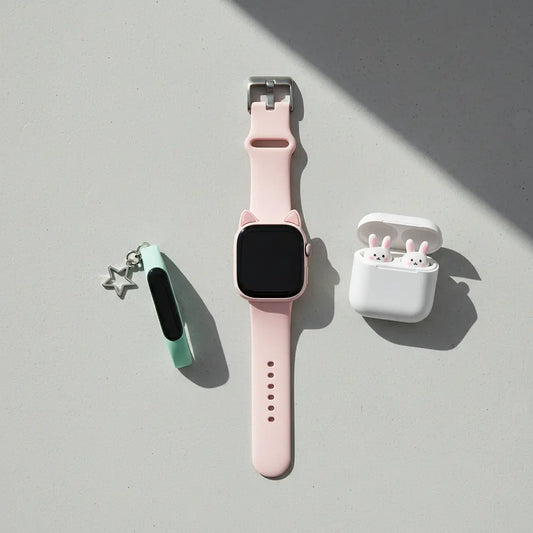
The Future of App-Controlled Cat Ears in Cosplay
The air in the convention hall hums—a familiar mix of excited chatter, distant panel speakers, and the rustle of a thousand costumes. But in 2025, a new sound joins the chorus: the soft, nearly silent whir of micro-servos. Your eyes land on a cosplayer whose neon-accented cat ears twitch, pivot, and glow in perfect sync with the beat of a viral TikTok dance they’re recording. The crowd around them isn’t just watching; they’re mesmerized.
This isn't a scene from a sci-fi anime. This is the new reality of cosplay, where the line between costume and technology has completely dissolved. At the forefront of this movement are app-controlled cat ears, the flagship example of how wearable tech is transforming self-expression. They represent a major shift from static props to dynamic, interactive extensions of our personality.
This article isn't just another product review. We’re exploring the cultural and technological forces that make these gadgets so significant. We'll break down how they work, why they hold such symbolic power, and what the future of cosplay technology holds. Get ready to understand why this trend is here to stay and how it’s shaping the very soul of modern fandom.
The Evolution of Cosplay Technology
Cosplay has always been about bringing the fantastic to life. In the beginning, this was an act of pure craft. Cosplayers used foam, fabric, and paint to build static replicas of their favorite character’s gear. The goal was accuracy, a perfect snapshot of a moment from a show or game.
The first wave of technology introduced light. Simple LED strips brought Iron Man's arc reactor to life and made magic staffs glow with otherworldly energy. These were game-changers, but they were passive. The light was either on or off. It added visual flair but didn't interact with the cosplayer or the world around them.
Soon, creators pushed for more. We saw the rise of more complex robotic cosplay accessories, like voice-activated lightsabers that hummed and clashed on cue or articulated wings that could spread with the press of a hidden button. This marked the critical shift from static props to interactive wearables. The costume was no longer just something you wore; it was something you operated.
This integration feels particularly natural for fandoms born from anime and video games. Characters in these mediums are hyper-expressive; their hair defies gravity, and their animal features—like cat ears—visibly react to their emotions. Technology finally gives cosplayers the tools to replicate that dynamic expressiveness, making app-controlled cat ears feel like a logical and exciting next step.
How App-Controlled Cat Ears Work
The secret behind these expressive accessories lies in a seamless partnership between hardware and software. At its core, a pair of Bluetooth controlled cosplay cat ears uses a tiny, low-energy Bluetooth chip to communicate with a dedicated application on your smartphone. The app is the command center, the brain of the entire operation.
But the real magic comes from the sensors embedded in the headband. Most modern sets include an accelerometer and a gyroscope—the same technology that allows your phone to know when you’ve rotated it. These sensors detect your head's movement, allowing the ears to react realistically. A sudden nod might make them perk up, while a slow tilt could cause one to droop inquisitively.
The Tech Breakdown: An Inside Look
The app is where personalization happens. It's not just an on/off switch. Through the app, you can:
- Control LED Lights: Change the color, brightness, and pattern of built-in LEDs to match your mood or outfit.
- Use Pre-Set Gestures: Select from a library of motions like "happy wiggle," "alert," or "relaxed."
- Create Custom Sequences: The best apps allow you to program your own series of movements and tie them to specific triggers.
For those just starting to explore this technology, understanding the basics is key. The foundational science behind these devices is fascinating. If you're curious about the mechanics that translate a tap on your phone into a realistic twitch, a great resource is our guide, "From Cute to Clever: What Are Moving Cat Ears?", which offers a perfect introduction to the science of expressive robotics in cosplay.
Cultural Symbolism: Why Cat Ears?
The power of cat ears extends far beyond their technical novelty. They are drenched in cultural meaning, tracing their lineage directly back to the *nekomimi* (cat person) archetype popular in Japanese anime and manga. In that context, cat ears are a visual shortcut for a character's personality—often signaling playfulness, mischief, independence, or cuteness.
Wearing them, especially interactive wearable cat ears, becomes a powerful act of identity expression. It’s a way of non-verbally communicating certain traits you identify with. For many, it's a badge of honor, a visible sign that you belong to a specific subculture that values creativity and playful expression. It's less about portraying one specific character and more about embodying a vibe.
A common misconception is that this trend is limited to a niche or a specific gender. In reality, one of the biggest strengths of cat ears is their accessibility. They aren't tied to a single, complex costume. They can be added to any outfit, from a full-blown cosplay to everyday streetwear, making them a popular entry point for anyone looking to experiment with expressive fashion.
We see this play out on social media constantly. A recent viral TikTok trend involved creators syncing their programmable cat ear headbands to popular audio clips, with the ears twitching and changing color in perfect rhythm. This transforms the accessory from a prop into a performance instrument. This phenomenon isn't just about ears, either; other animal features are also becoming identity markers. To see how this trend extends to other accessories, explore our analysis in "From Anime Con to Everyday: Why Fox Tails Are Trending."
Where This Tech is Heading: 2025 and Beyond
The current generation of app-controlled cat ears is just the beginning. The next frontier is intelligence. We are on the cusp of AI-powered cosplay cat ears that do more than just react to physical motion; they will interpret context and emotion. Imagine ears that automatically droop slightly when your playlist shifts to a sad song or perk up when your phone receives an excited message from a friend.
This evolution from reactive to proactive accessories will deepen the connection between the wearer and their gear. Think of current models as a flip phone—fun and functional. The future is a smartphone, fully integrated into your digital life and running multiple "emotional apps" at once. Forecasts predict the wearable tech market will see consistent growth, with a major slice driven by these non-fitness "expressive wearables."
Quick Poll: Your 2025 Cosplay Tech Wishlist
Which next-gen cosplay gadget are you most excited to try?
Integration with other platforms is the next logical step. Picture your real-world cat ears' movements being perfectly mirrored by your VRChat avatar for a truly blended reality experience. At an anime convention, an AR app on a friend's phone could display digital sparkles or lightning bolts emanating from your physical ears, creating a shared interactive experience.
This tech is also destined to break out of the convention hall. The lines between cosplay and alternative street style are already blurring. Smart headbands with interactive elements are poised to become a staple at music festivals and in the everyday fashion of Gen Z and beyond. For the most ambitious creators who are ready to engineer the future themselves, our comprehensive tutorial on making DIY Animatronic Cat Ears with Arduino is the ultimate resource, exploring the integration of advanced sensors and AI-driven movement patterns.
What Cosplayers Should Consider Before Buying
Making a smart purchase is about navigating the hype to find real value. The biggest fear for any early adopter is investing in a gimmick—a product that looks cool but lacks the support or functionality to last. When it comes to cosplay wearables, the hardware is only half of the equation; the companion app is just as important.
You'll need to find the right balance between cost and features. The market for affordable app-controlled cat ears is growing, but sometimes a lower price means sacrificing customization or battery life. On the other hand, the most expensive models might offer professional-level programming that a casual user may never need. The key is to match the product to your personal goals.
Brand reliability is paramount. A good brand will provide regular firmware and app updates, fixing bugs and sometimes even adding new features long after your purchase. A pro-tip is to download the companion app before you buy the ears. If the app is free to explore, check its design and reviews. A clunky, outdated app is a major red flag for the entire product experience.
For those ready to find that perfect balance, some models stand out. Our Interactive Anime Cat Ears are an excellent example of a product that delivers high-impact expression without overwhelming complexity. With gravity-responsive technology and dual-speed modes, they provide dynamic movement right out of the box, making them one of the best app-controlled cat ears for cosplay beginners and veterans alike.
Your Pre-Purchase Tech Checklist
To ensure you make a confident choice, use this checklist before you buy:
- Bluetooth Version: Look for Bluetooth 5.0 or higher. This ensures a more stable connection and better range, which is crucial in a crowded convention center.
- App Customization: Can you create and save your own movement patterns? The ability to program gestures is what separates a basic toy from a true performance tool.
- Battery Life: Aim for a minimum of 3-5 hours of continuous use on a single charge. Nothing is worse than your tech dying halfway through the day.
- App Store Reviews: Read recent reviews for the companion app on the Apple App Store or Google Play. Look for complaints about connectivity, crashes, or lack of updates.
- Comfort and Weight: You’ll be wearing this for hours. Check for a lightweight design and adequate padding on the headband to avoid a mid-con headache.
The Future is Expressive
The rise of app-controlled cat ears is more than a fleeting trend. It’s a powerful symbol of where personal expression is heading. This technology stands at the intersection of fandom culture, wearable tech, and identity, offering a new language for cosplayers and fashion enthusiasts to communicate with the world.
For anyone worried about investing in a passing gimmick, rest assured. This movement is part of a larger cultural shift towards interactive and authentic self-expression. The future of cosplay technology is not just about looking the part, but feeling and acting it, too. These devices are the tools that make that possible.
Your journey into expressive tech is just starting. Continue to explore our other guides on the latest cosplay wearables to stay ahead of the curve. For live trend reports and inspiration from the biggest conventions, follow us on our social channels. To get exclusive previews of the next generation of robotic cosplay accessories, subscribe to our newsletter today.
Frequently Asked Questions (FAQ)
Most models offer between 3 to 5 hours of continuous use. Battery life can vary based on the intensity of the movements and whether you are using integrated LED lights. For all-day convention wear, it's wise to bring a portable power bank to recharge during a break.
It depends on the model. Some basic versions may have a default movement mode that works without a connection, such as reacting to gravity or sound. However, to access custom gestures, LED color changes, and programmed sequences, you will almost always need to be connected to the app.
While the underlying technology is complex, the user experience is designed to be simple. Future AI-driven models will likely use an intuitive app interface where you can select "emotional profiles" or link the ears to other apps (like your music player) with just a few taps. The goal is for the tech to feel magical, not complicated.
The difference usually comes down to three things: the quality of the motors (smoother, quieter movement), the sophistication of the app (more customization options), and the reliability of the brand (better support and updates). Cheaper models are great for trying the trend, while more expensive ones are a better investment for serious performers and creators.




